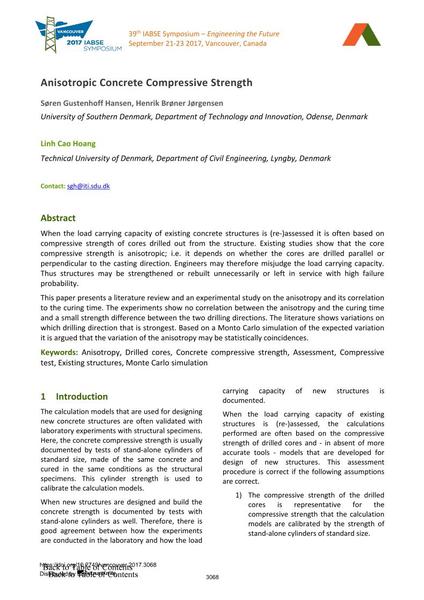Anisotropic Concrete Compressive Strength

|
|
|||||||||||
Détails bibliographiques
| Auteur(s): |
Søren Gustenhof Hansen
(University of Southern Denmark, Department of Technology and Innovation, Odense, Denmark)
Henrik Brøne Jørgensen (University of Southern Denmark, Department of Technology and Innovation, Odense, Denmark) Linh Ca Hoang (Technical University of Denmark, Department of Civil Engineering, Lyngby, Denmark) |
||||
|---|---|---|---|---|---|
| Médium: | papier de conférence | ||||
| Langue(s): | anglais | ||||
| Conférence: | IABSE Symposium: Engineering the Future, Vancouver, Canada, 21-23 September 2017 | ||||
| Publié dans: | IABSE Symposium Vancouver 2017 | ||||
|
|||||
| Page(s): | 3068-3075 | ||||
| Nombre total de pages (du PDF): | 8 | ||||
| Année: | 2017 | ||||
| DOI: | 10.2749/vancouver.2017.3068 | ||||
| Abstrait: |
When the load carrying capacity of existing concrete structures is (re-)assessed it is often based on compressive strength of cores drilled out from the structure. Existing studies show that the core compressive strength is anisotropic; i.e. it depends on whether the cores are drilled parallel or perpendicular to the casting direction. Engineers may therefore misjudge the load carrying capacity. Thus structures may be strengthened or rebuilt unnecessarily or left in service with high failure probability. This paper presents a literature review and an experimental study on the anisotropy and its correlation to the curing time. The experiments show no correlation between the anisotropy and the curing time and a small strength difference between the two drilling directions. The literature shows variations on which drilling direction that is strongest. Based on a Monto Carlo simulation of the expected variation it is argued that the variation of the anisotropy may be statistically coincidences. |
||||
| Mots-clé: |
structures existantes
|
||||
